Welcome tothe Nexus
A Basic Guide to Heroes of the Storm
 Welcome to the Nexus! It’s your chance to take on a legendary hero from the Blizzard universe, and fight across a variety of maps and settings. Battle as Raynor, in the shifting sands of Sky Temple. Dive into the sinister Haunted Mines as Jaina, and defeat the giant golem within. Spread terror with Diablo as you fight for tributes for the dark raven lord. Venture into the Nexus, clash against other teams, and crush them, or be crushed! There’s just one tiny issue. You suck.
Welcome to the Nexus! It’s your chance to take on a legendary hero from the Blizzard universe, and fight across a variety of maps and settings. Battle as Raynor, in the shifting sands of Sky Temple. Dive into the sinister Haunted Mines as Jaina, and defeat the giant golem within. Spread terror with Diablo as you fight for tributes for the dark raven lord. Venture into the Nexus, clash against other teams, and crush them, or be crushed! There’s just one tiny issue. You suck. Lets get to fixing that! First of all this guide assumes you've experienced the tutorial, so we won't bother to re-explain how right clicking works, or how to move. We'll move on to expand the basic knowledge of the game like “what hero to pick” and “halp, I am gank”. If you haven’t played the tutorials, here’s how

Completing the tutorial rewards 1000 gold. Get to it.
If you have never played a moba-like game before this (or arena brawler, as Blizzard likes to call it), this will be new territory for you. It will be hard from the start. If you’ve played mobas before, this will not be like DotA2 or League of Legends which you may be familiar with. This is still a team game with an emphasis on strategy and teamwork, and many of the concepts in this guide may be familiar to you. However, it's still recommended that you read this guide, the flow of the game is quite different from what you may know, and a little bit of knowledge goes a long way. For players who’ve never played before, we will try to break down things as much as possible. At its core, this is game that is easy to learn and hard to master, one that will become more deep and interesting with experience.
This guide will attempt to cover a broad number of concepts and ideas in as painless a way as possible. Knowledge is power, and knowing what you’re doing will allow you to find victory. Hopefully this will be the guide to your journey into the Nexus.
Heroes
In Heroes of the Storm heroes are separated into four different archetypes: Assassins, Warriors, Supports, and Specialists. The goal of these categories is to let you build a balanced team that can cover all the bases needed to win. Generally speaking a solid team wants at least one assassin, one support and one Warrior.
Warrior
These heroes are usually have high HP pools and have abilities and talents to reduce incoming damage. They are primarily melee. They are meant to soak up the incoming damage or being annoying in a fight while being hard to kill. Due to their extreme durability, they can often deal lots of damage by virtue of surviving for the entire fight.
Assassin
The Assassins are what in other games we’d call a DPS. They can be melee or ranged heroes, but their main contribution is dealing damage. They’re usually fragile to compensate for their high damage output.
Support
These heroes aid their teammates in battle. They usually have a heal to restore health or shields to prevent damage to allies. Sometimes they have buffs for their allies that can help heroes do more damage, reduce or prevent damage.
Specialist
Heroes that do not fall in the other classes are labeled as specialists. They can be tanky or do good DPS, but majority of the time specialists are good at pushing lanes. This is also where you’ll often find the wonkiest mechanics.
Choosing your Hero
First thing first: You’re solo queuing, you want to have fun games, where you being relatively new won’t completely rob you of your chances at victory. Good news, there’s a variety of heroes that are fairly easy to play. We have included a list of easy to play heroes for your convenience. Blizzard has also labeled Heroes from Easy to Very Hard. Err towards “easy” heroes. While you can test out any hero you desire in the shop or play Cooperative Mode (a team of people vs CPUs), there is a limited rotation of free heroes. What hero you play is going to depend on what’s available in the free to play rotation.
 Li Li
Li Li
The easiest healer to play, her healing ability automatically targets the lowest HP hero in its radius, making it very much a fire and forget ability. Cloud serpent is an easy DPS boost for your team. Just plop it on someone who’s going to go into battle. Blinding Wind can be very irritating against certain heroes, like Illidan, or Nova, who want to frontload their rightclick damage. Jugs of 1,000 Cups is a great tool to sustain your team through teamfights, just be careful to not get stunned while channeling it.
Primary Abilities | Heroic Abilities | Heroic Trait | |||||
 Healing Brew Healing BrewHeal lowest Health ally (prioritizing Heroes) for a moderate amount of Health. |  Cloud Serpent Cloud SerpentSummon a Cloud Serpent on target allied Hero that automatically attacks nearby enemies, doing light damage. Heroes can only have 1 Cloud Serpent at a time. Lasts for 8 seconds. |  Blinding Wind Blinding WindThrow a cloud of Blinding Wind at the 2 nearest enemies (prioritizing Heroes), dealing moderate damage. Targets miss their next 2 Basic Attacks in the next 4 seconds. |  Jug of 1,000 Cups Jug of 1,000 CupsRapidly tosses brew to the most injured nearby allies, prioritizing Heroes, restoring a massive amount of Health over 6 seconds. |  Water Dragon Water DragonSummon a Water Dragon that after a delay hits the nearest enemy Hero and all enemies near them, dealing heavy damage and slowing their Movement Speed by 70% for 4 seconds. |  Fast Feet Fast FeetUpon taking damage, gain 10% Movement Speed for 1 second. | ||
Recommended Build
 Conjurer's Pursuit Conjurer's PursuitGather Regeneration Globes to increase Mana Regeneration. |  Healing Ward Healing WardActivate to place a ward which heals in an area. |  The Good Stuff The Good StuffHealing Brew also heals over time. |  Jug Of 1,000 Cups Jug Of 1,000 CupsRapidly heal nearby allies. |  Shrink Ray Shrink RayActivate to reduce an enemy Hero’s damage. |  Herbal Cleanse Herbal CleanseHealing Brew removes disables and gives movement speed. |  Jug of 1,000,000 Cups Jug of 1,000,000 CupsThrow out two cups at a time. |
| 1 | 4 | 7 | 10 | 13 | 16 | 20 |
 Malfurion
Malfurion
Following the theme of “beards are awesome”, Malfurion is both a strong healer, and very disruptive. AoE rooting can destroy entire teams, and your Heroic Abilities are fantastic. Do keep in mind that your healing is over time, rather than burst healing, so apply it preventively, and use it on allies that aren’t quite critically injured yet. All your offensive abilities require prediction, as both roots and Moonfire have a very visible animation, between casting and them taking effect. The mere threat of their presence can be as impactful as landing them though.
Primary Abilities | Heroic Abilities | Heroic Trait | |||||
 Regrowth RegrowthHeal target ally for a moderate amount of Health instantly and an additional large amount of Health over 10 seconds. |  Moonfire MoonfireDeals light damage to enemies within target area and reveals them for 2 seconds. |  Entangling Roots Entangling RootsRoot enemies within the target area for 1.5 seconds, and deals light damage over the duration. Affected area grows over 3 seconds. |  Tranquility TranquilityHeals a moderate amount of Health each second to nearby allies over 10 seconds. |  Twilight Dream Twilight DreamAfter a short delay, deal massive damage in a large area around you, silencing enemies for 3 seconds. |  Innervate InnervateGrant target allied Hero a large amount of Mana over 10 seconds. | ||
Recommended Build
 Conjurer's Pursuit Conjurer's PursuitGather Regeneration Globes to increase Mana Regeneration. |  Protective Shield Protective ShieldActivate to shield an allied Hero. |  Enduring Growth Enduring GrowthIncreased Regrowth duration. |  Tranquility TranquilityHeals nearby allies over time. |  Life Seed Life SeedNearby Heroes passively receive Regrowth periodically. |  Hardened Focus Hardened FocusFaster cooldowns near full Health. |  Serenity SerenityTranquility has increased healing and grants mana. |
| 1 | 4 | 7 | 10 | 13 | 16 | 20 |
 Muradin
Muradin
Muradin is what could be referred to as a “disruptor” tank. A good build for him revolves around jumping into teamfights, stunning and slowing, and then jumping out. This makes him both a good initiator and good backup. Muradin is surprisingly difficult to catch, and with the right build can be a real pain to contend with. Spam your Stormbolt as much as possible to build up those Perfect Storm charges. Dwarf Toss is okay for running away, although ideally you want to avoid being caught out in the first place.
Primary Abilities | Heroic Abilities | Heroic Trait | |||||
 Stormbolt StormboltThrow a hammer, dealing moderate damage to the first enemy hit and stunning it for 1.5 seconds. |  Thunderclap ThunderclapDeals moderate damage and slows enemies by 25% for 2.5 seconds. |  Dwarf Toss Dwarf TossLeap to target location, dealing moderate damage to enemies on landing. | Transform for 20 seconds, gaining a massive amount of Health and causing your Basic Attacks to stun enemies. |  Haymaker HaymakerStun target enemy Hero, and wind up a punch dealing massive damage and knocking the target back, hitting enemies in the way for moderate damage and knocking them aside. |  Second Wind Second WindRestore a moderate amount of Health each second when you have not taken damage for 4 seconds. When below 40% Health, Health restored per second doubles. | ||
Recommended Build
 Perfect Storm Perfect StormIncreased range of Multishot |  Sledgehammer SledgehammerIncreased damage versus Structures and Minions, destroys ammo. |  Piercing Bolt Piercing BoltPenetrates to hit up to 2 targets. | Temporary Health boost and Basic Attacks stun. |  Burning Rage Burning RageDeals damage to nearby enemies. |  Stoneform StoneformActivate to heal over time. |  Rewind RewindActivate to reset cooldowns. |
| 1 | 4 | 7 | 10 | 13 | 16 | 20 |
 Tassadar
Tassadar
A surprisingly versatile hero: Psionic Storm actually outputs decent damage, proper use of shields can mitigate a ton of damage, and you have a wonderful escape in Dimensional Shift, and Oracle turns you into a walking watch tower that ruins invisible heroes. Tassadar is all about prediction, predict teamfights so you can pre-shield, use Oracle to scout out, and storm to hit as many enemies as possible. Remember that taking Mule and Reinforce Structure can be very potent on certain maps, especially Sky Temple and Haunted Mines.
Primary Abilities | Heroic Abilities | Heroic Trait | |||||
 Plasma Shield Plasma ShieldShield target ally, absorbing a massive amount of damage for 8 seconds. |  Psionic Storm Psionic StormDeal moderate damage each second to enemies in target area for 3 seconds. |  Dimensional Shift Dimensional ShiftBecome invulnerable and fully invisible for 1.5 seconds. |  Archon ArchonTransform into an Archon, gaining a massive Shield, causing Basic Attacks to deal moderate damage and splash for half additional damage. Lasts for 12 seconds. |  Force Wall Force WallCreate a wall that blocks all units from moving through it for 2.5 seconds. |  Oracle OracleGreatly increases your vision radius and allows you to detect Stealthed enemy Heroes. Lasts for 5 seconds. | ||
Recommended Build
 Conjurer’s Pursuit Conjurer’s PursuitGather Regeneration Globes to increase Mana Regeneration. |  Healing Ward Healing WardActivate to place a ward which heals in an area. |  Deep Shift Deep ShiftIncreased duration of Dimensional Shift. |  Archon ArchonUnleashes a flurry of arrows at enemies. |  Prescience PrescienceGains Basic Attack damage and a Shield. |  Dimensional Warp Dimensional WarpIncreases Movement Speed and gain Health while using Dimensional Shift. |  Twilight Archon Twilight ArchonIncreased Shield, damage, and Basic Attack range. |
| 1 | 4 | 7 | 10 | 13 | 16 | 20 |
 Uther
Uther
Uther is one of the strongest healers in the game, although his cooldowns mean he can’t heal as much as he’d like. The ability to still heal after being picked off, is hard to overstate, and even a dead Uther can save a dying teammate. When building Uther, consider the enemy composition carefully, sometimes Divine Shield is better than Divine Storm. Also consider Clairvoyance if you’re swimming in invisible heroes or need better map control. Be aware that this build has a lot of buttons to press.
Primary Abilities | Heroic Abilities | Heroic Trait | |||||
 Holy Light Holy LightHeal an ally for a large amount of Health. |  Holy Radiance Holy RadianceHeal all allies in a line for a large amount of Health, dealing moderate damage to enemies. |  Hammer of Justice Hammer of JusticeDeals moderate damage and stuns the target for 1 second. |  Divine Shield Divine ShieldMake an allied Hero Invulnerable and increase their Movement Speed by 20% for 3 seconds. |  Divine Storm Divine StormDeal moderate damage and stun nearby enemies for 1.5 seconds. |  Eternal Devotion Eternal DevotionUpon dying, become an Invulnerable spirit for up to 10 seconds. Your Abilities and Basic Attacks do 50% healing and damage. | ||
Recommended Build
 Conjurer's Pursuit Conjurer's PursuitGather Regeneration Globes to increase Mana Regeneration. |  Protective Shield Protective ShieldActivate to shield an allied Hero. |  Cleanse CleanseMakes target immune to disables. |  Divine Storm Divine StormDamage and stun nearby enemies. |  Shrink Ray Shrink RayActivate to reduce an enemy Hero’s damage. |  Hardened Focus Hardened FocusFaster cooldowns near full Health. |  Divine Hurricane Divine HurricaneIncreases Divine Storm radius and reduces cooldown. |
| 1 | 4 | 7 | 10 | 13 | 16 | 20 |
 Valla
Valla
A ranged assassin, Valla is on the rather fragile end of the spectrum. However she makes up for this by outputting a ton of damage. A great hero to learn positioning with, her Vault ability lets her reposition with ease, while her Heroic Abilities are very impactful. Try to focus on hitting as many targets as possible with multishot, and staying alive. We suggest a build here that focuses on using multishot to deal damage from a safe distance.
Primary Abilities | Heroic Abilities | Heroic Trait | |||||
 Hungering Arrow Hungering ArrowFire an arrow that deals moderate damage to the first target hit, then seeks up to 2 additional enemies dealing half the initial damage. Can hit an enemy multiple times. |  Multishot MultishotDeal moderate damage to enemies within the target area. |  Vault VaultDash to the target area. |  Rain of Vengence Rain of VengenceLaunch 2 waves of Shadow Beasts that deal heavy damage to enemies within the target area, stunning for 0.5 seconds per wave. |  Strafe StrafeRapidly attack nearby visible enemies with each hit dealing light damage, prioritizing heroes over minions. Valla is able to move and use Vault while strafing. Lasts for 4 seconds. |  Hatered HateredBasic Attacks grant a stack of Hatred, up to 10. Each Hatred stack increases Basic Attack damage by 2% and Movement Speed by 1%. | ||
Recommended Build
 Composite Arrow Composite ArrowIncreased range of Multishot. |  Arsenal ArsenalMultishot launches grenades with the arrows. |  Repeating Arrow Repeating ArrowVault refreshes Hungering Arrow. |  Strafe StrafeUnleashes a flurry of arrows at enemies. |  Frost Shot Frost ShotSlows enemies. |  Blood for Blood Blood for BloodActivate to slow and steal Health from your target. |  Bolt of the Storm Bolt of the StormActivate to teleport a short distance. |
| 1 | 4 | 7 | 10 | 13 | 16 | 20 |
 Zagara
Zagara
A ranged hero, all her abilities are moderately long ranged, and have the potential to do damage even if you’re not staying in the fight, in addition to a very teamfight centric Heroic Ability and the ability to split push if you so desire. Remember to target high priority enemies with your Hydralisks, and that Banelings hurt if the enemy doesn’t dodge them. Avoid getting over eager with your pushing, lest you be punished.
Primary Abilities | Heroic Abilities | Heroic Trait | |||||
 Baneling Barrage Baneling BarrageLaunch 4 Banelings that deal moderate splash damage each. |  Hunter Killer Hunter KillerSummon a Hydralisk to attack a single target, dealing moderate damage. Lasts 8 seconds. |  Infested Drop Infested DropBombard target area with a Zerg Drop Pod for moderate damage. The pod spawns 2 Roachlings that deal light damage and last for 8 seconds. |  Devouring Maw Devouring MawSummons a Devouring Maw that deals moderate damage and devours enemies for 4 seconds. Devoured enemies cannot fight. |  Nydus Network Nydus NetworkSummon a Nydus Worm at target location that you can enter by right-clicking. While inside, you exit by targeting a Nydus Worm with R or right-clicking near the Worm. Maximum 4 Nydus Worms. |  Creep Tumor Creep TumorLay a Creep Tumor that generates Creep. You and your summons move 20% faster on Creep and restore a small amount of Health each second. Tumors last 240 seconds. | ||
Recommended Build
 Reconstitution ReconstitutionIncreased Health Regeneration on Creep. |  Envenomed Spines Envenomed SpinesIncreased Basic Attack range and damage. |  Endless Creep Endless CreepCreep spreads farther. Increased tumor health. |  Devouring Maw Devouring MawEats enemies in area. |  Grooved Spines Grooved SpinesIncreased Hunter Killer range and damage. |  Brood Expansion Brood ExpansionCan hold 2 charges of Hunter Killer. |  Bolt of the Storm Bolt of the StormActivate to teleport a short distance. |
| 1 | 4 | 7 | 10 | 13 | 16 | 20 |
Now, a caveat, we selected these heroes based on ease of play, not metagame popularity or game impact. Be aware, there are some heroes that are just not very newbie friendly, while you can play them, you will probably have a miserable time, as they require a certain amount of experience on how the game works and the general flow of the game. Unless you’re taken by the idea of playing them, try to avoid the following heroes for the first few games:
- Lost Vikings
- Abathur
- Illidan
- Kerrigan
- Sgt.Hammer
- Murky
Given with some time and patience, you can learn any hero. Just don’t expect to pick up Illidan and be a killing machine in your first game, or you will be sorely disappointed.
Talent Selection
 Talents are the foundation of the game. Good talent choices make heroes notably stronger, or more versatile. At first, your heroes are going to be Talent Locked, which you won’t be able to pick certain talents until you’ve played enough games with the hero (heroes talents are fully unlocked at level 4.), or you’ve reached level 25 on your account. Cooperative games against the AI count to gain EXP for your hero and account level, which is one reason we suggest cooperative games.
Talents are the foundation of the game. Good talent choices make heroes notably stronger, or more versatile. At first, your heroes are going to be Talent Locked, which you won’t be able to pick certain talents until you’ve played enough games with the hero (heroes talents are fully unlocked at level 4.), or you’ve reached level 25 on your account. Cooperative games against the AI count to gain EXP for your hero and account level, which is one reason we suggest cooperative games.Whether or not you’re talent gated, keep in mind that it's generally better to build either towards specialization or towards remedying specific weaknesses. Talents in game are gained at level 4, 7, 10, 13, 16 and 20. For example, one popular Valla build focuses on taking all the talents that affect multishot, to turn it into a deadly weapon. Many heroes consider taking Blink at level 20, as it makes for a strong escape, remedying the lack of an innate ability to reposition, like Valla’s Vault.
It is always recommended to research your hero, the internet is full of guides, use google. Don’t just make decisions blindly based on a guide though, check what the enemy composition is, look at the map and try to see what may be useful. One example, against a composition that has a lot of high magic burst, taking Spell Shield can be optimal. Another example, on a map like Haunted Mines, or Sky Temple, taking Mule can allow you to save buildings that would otherwise die. Sometimes an unorthodox talent choice is what’s called for against a particular composition. You can always ask your team or alt tab for a quick search. The point of talents is to let you adapt your hero to the particular game, don’t hesitate to experiment.
Battlegrounds
In Heroes of the Storm there isn’t only one map, but seven (with more to come). These maps are called battlegrounds and they are all different and unique in their own way. Each different map has different objectives that shape the way the game flows. For example, Blackheart’s Bay is all about collecting doubloons to supplement your attacks with pirate based artillery support, while Dragon Shire revolves around capturing shrines to harness the power of the Dragon Knight. Mercenaries on these maps are a constant but ever present objective that can help or hinder your team immensely. Well timed, mercenaries can force the enemy to make impossible decisions about taking objectives while defending.
 Blackheart's Bay
Blackheart's Bay
 A coin collection map! Here you seek to find doubloons, to give to the ghostly pirate that sits in the bay. Doubloons are found in chests that spawn near the middle of the map every little while, and from mercenary camps. Mercenaries drop two coins, while chests drop five. If a hero carrying doubloons dies, he drops his loot, allowing other heroes to pick it up. When the doubloons are paid to the ghostly pirate, he turns his cannons on your enemies, showering their buildings with deadly shrapnel. A team that doesn’t contest this by keeping the enemy from turning in, will soon find their buildings turning to rubble. Keep in mind the following, or you’ll be swimming with the fishes.
A coin collection map! Here you seek to find doubloons, to give to the ghostly pirate that sits in the bay. Doubloons are found in chests that spawn near the middle of the map every little while, and from mercenary camps. Mercenaries drop two coins, while chests drop five. If a hero carrying doubloons dies, he drops his loot, allowing other heroes to pick it up. When the doubloons are paid to the ghostly pirate, he turns his cannons on your enemies, showering their buildings with deadly shrapnel. A team that doesn’t contest this by keeping the enemy from turning in, will soon find their buildings turning to rubble. Keep in mind the following, or you’ll be swimming with the fishes.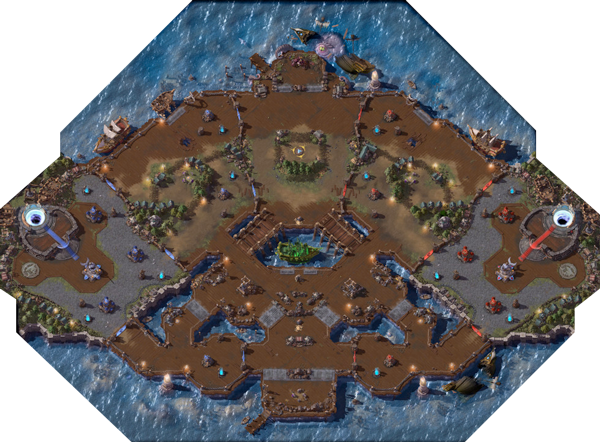
- Its important to try to take out one of the center towers before turning in coins, this ensures that the cannons deal enough damage to bring down the fort.
- Controlling the center is key. Being able to contest turn-ins is critical to winning.
- The small pirate camps only drop coins, but respawn fairly quickly and are worth bringing down.
- The center tower is important to control to keep the enemy from sneaking into the golem.
- All the merc camps in this map are relatively out of the way, if you are behind and have good map awareness, it is possible to collect the mercenaries mostly avoiding the enemy team. Turning in the coins might be a challenge though.
If you’re ahead, the enemy should not be allowed to turn in. Keep them away from the pirate and control the merc camps - This map can theoretically be won without setting foot in the enemy base, the pirate does a lot of damage, and once a couple forts go down, it’s easy to keep a level advantage.
- Avoid being picked off! This map encourages splitting up to gather doubloons, and then joining up to turn in, but being too greedy can cost you the game.
- Coins are life, losing a hero with 12 coins is equivalent to losing a fort. Not always, but most of the time.
 Dragon Shire
Dragon Shire
 As the name indicates, there is a dragon. Who is also a Knight. Key points to remember about this map. Three lanes, five mercenary camps. Two shrines, that when captured allow a Hero in the center of the map to become the titular Dragon Knight. This is a massive unit that breathes fire, which is helpful for clearing waves. Kicks opponents away, and deals massive damage to buildings. The key mechanic is balancing capturing the shrines, while avoiding having the enemy capture the shrines. A few tips:
As the name indicates, there is a dragon. Who is also a Knight. Key points to remember about this map. Three lanes, five mercenary camps. Two shrines, that when captured allow a Hero in the center of the map to become the titular Dragon Knight. This is a massive unit that breathes fire, which is helpful for clearing waves. Kicks opponents away, and deals massive damage to buildings. The key mechanic is balancing capturing the shrines, while avoiding having the enemy capture the shrines. A few tips: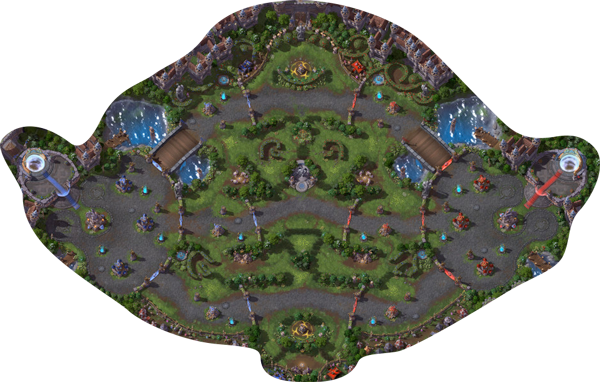
- The middle neutral camp is a bruiser camp, and can be captured if you’re holding the bottom shrine. Take care not to be spotted by the enemy and killed though.
- The bottom lane on this map is critical, its positioning near mercenaries and ease of rotation to the middle lane make it invaluable.
- This map often finds itself “stalemated” where no one can capture the dragon knight successfully. This is normal and completely fine. Don’t get aggressive and make mistakes as a result,
- Activating the Dragon Knight takes approximately 5 seconds, but it can be interrupted.
- If the enemy concentrate their forces, they will be unable to hold the shrines.
- The proximity of the shrines to the lanes, means that it is possible to both gather exp and defend the shrines.
- The dragon scales with level, so he’s never completely outdated.
- The dragon’s good building damage makes him ideal for sieging, not so much for dishing out damage in teamfights
- One of the dragon’s abilities allows him to kick enemies away. Use this proactively to force the enemy to engage 4 v 5, and please, don’t use it on enemy heroes that are currently being focused down by your team
- If you’re away from your team, it's perfectly possible to punt a lone hero, straight into your team. Do this and watch them evaporate
- Keeps have 50% movement speed and attack speed slowing effect, try to use minions to tank the keeps, as opposed to the dragon, lest his damage drop significantly.
- In general, if the enemy captures mercenaries on their side, you can use the ones on your side to counter them since the camps are mirrored
- The dragon has an ability that causes it to exit dragon form. Try to avoid using it by mispressing its hotkey.
 Cursed Hallow
Cursed Hallow
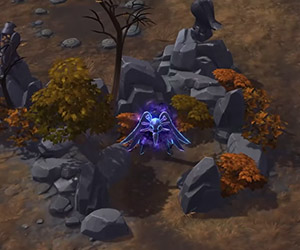 A map that focuses on collecting tributes that will in turn curse the enemy team. This is widely considered one of the most balanced maps in the pool. It features one of each type of mercenary on each side of the map, giving a nice balance of opportunities. Tributes spawn every few minutes, and when a team has captured three, the enemy team is cursed, reducing all their minions to one hp, and preventing their forts from firing for the 70 second duration. A few tips
A map that focuses on collecting tributes that will in turn curse the enemy team. This is widely considered one of the most balanced maps in the pool. It features one of each type of mercenary on each side of the map, giving a nice balance of opportunities. Tributes spawn every few minutes, and when a team has captured three, the enemy team is cursed, reducing all their minions to one hp, and preventing their forts from firing for the 70 second duration. A few tips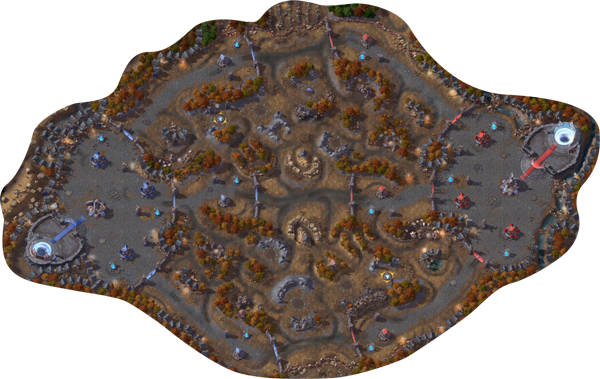
- The Golems are obscenely strong, and in most cases require the cooperation of at least three Heroes to bring down. There are some exceptions, but be exceedingly careful.
- It's sometimes worth ignoring a tribute if your team is out of position, and the enemy team has time to set up.
- Even being cursed isn’t the end of the world, it hurts, but it is a loss that can be made up.
- The most important tribute is the one that bestows a curse. Losing one or two tributes to maximise experience gain can actually be beneficial.
- In general though, get your whole team to go after the tribute. Nothing hurts as much as feeding your team one member at a time into the meatgrinder
- Collecting the tribute requires channeling for approximately 6 seconds, and can be interrupted.
- When you win a teamfight, consider doing the enemies mercenaries instead of pushing.
- On this map, more than many others, knowing where the enemy team is, is crucial to an effective defense or offense.
- Catching the enemy trying to get the golem can turn a game around.
- The tribute doesn’t spawn in the same place twice in a row.
 Garden of Terror
Garden of Terror
 A map with a day and night cycle, the main objective is to obtain seeds, so you may grow Garden Terrors. The game begins in daytime and after ninety seconds, cycles to night . When night falls, two neutral garden terrors, called Shamblers, spawn, along with a few podlings. When slain, these drop seeds. Each camp drops exactly 90. At 100 seeds, a garden terror spawns in your base, which may be piloted by a hero. Seeds persist between nights, so a team that gathers 97 seeds the first night, only needs to gather three more the following night. The terror is a strong team fighter and siege engine, and can give your team a strong advantage. The six evenly split merc camps make for an additional objective.
A map with a day and night cycle, the main objective is to obtain seeds, so you may grow Garden Terrors. The game begins in daytime and after ninety seconds, cycles to night . When night falls, two neutral garden terrors, called Shamblers, spawn, along with a few podlings. When slain, these drop seeds. Each camp drops exactly 90. At 100 seeds, a garden terror spawns in your base, which may be piloted by a hero. Seeds persist between nights, so a team that gathers 97 seeds the first night, only needs to gather three more the following night. The terror is a strong team fighter and siege engine, and can give your team a strong advantage. The six evenly split merc camps make for an additional objective.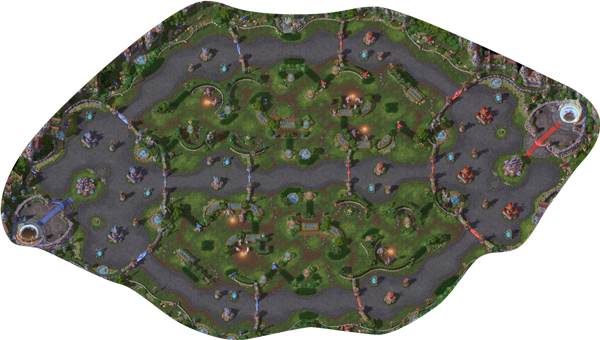
- The first night begins at 1:30 minutes into the game.
- When collecting seeds, focus on killing the smaller camps before going after the more threatening Shamblers.
- You can see smaller plants (Podlings) on the mini-map. If they start dying, there’s a good chance the enemy is about to start attacking the Shambler nearest to them.
- The Terror has a sprint ability, which you should use as often as possible, in order to rush towards the enemy.
- The Spore Queen’s Curse, is a polymorph ability that can disable many enemies at once, if well aimed. If you see a pulsing circle around your feet, get out of it, before you become a plant.
- Plant Horror Overgrowth deals massive damage to buildings but is susceptible to focus fire. If you see a massive flowerpot entangling your buildings, kill it.
- Terror on Terror action revolves around positioning. Remember that horrors will die after a set time
If no one activates the Terror, it will wither and die after 1 minute. This is a waste of seeds. Don’t do that. - One of the horrors abilities is to exit horror form. Do try to avoid using that unless you intend to.
 Haunted Mines
Haunted Mines
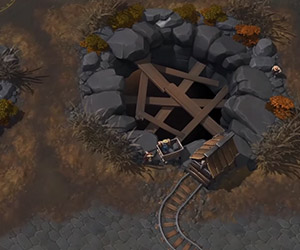 A controversial map to say the least. While the map at first appears simplistic, containing only two lanes and three mercenary camps, it isn’t. Soon after the game starts, at approximately 2 minutes, the mines open, which are filled with zombies. When slain, these zombies drop skulls. Both teams contest for skulls in the mines below the main battlefield. When all the skulls are taken, each team is granted a golem, much like its mercenary counterpart in other maps, however its power scales with the number of skulls collected.
A controversial map to say the least. While the map at first appears simplistic, containing only two lanes and three mercenary camps, it isn’t. Soon after the game starts, at approximately 2 minutes, the mines open, which are filled with zombies. When slain, these zombies drop skulls. Both teams contest for skulls in the mines below the main battlefield. When all the skulls are taken, each team is granted a golem, much like its mercenary counterpart in other maps, however its power scales with the number of skulls collected.
- There are only two access points into the mines, both in the middle of a lane.
- Remember that the mine entrances can be used to dodge ganks, hide, and generally flee. Using the mine exit is an uninterruptible channeled ability, that will usually buy you the time to flee, if you survive.
- This is a relatively fast map. The first engagements will give the winning team a large advantage.
- Losing heroes right as the mines open is a reliable way to lose the game. Be extra cautious.
- Zombies show up on the mini-map, so you can see where the enemy is killing zombies by looking at the mini-map, and seeing where they’ve vanished.
- The golem’s power scales really quickly, so skulls become even more important as the game goes on.
- Timing on the mercenary camps is critical. Capture them to coincide with your golem, ideally they’ll engage the enemy golem and put the hurt on it.
- If you’re outmatched in the mines, and cannot grab many skulls, go after the center mercenaries.
- Sometimes you can dive past the enemy to steal a bunch of skulls. You might die, but it can be worth it.
- The two biggest zombie packs are where the majority of the skulls are. Those are your priority when you go into the mines.
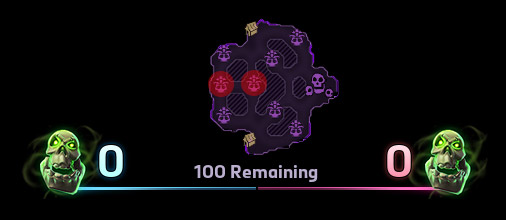
- The big golem in the center of the mines gives 30 skulls. If you can get all the smaller zombies in the mines, its almost not worth bringing down.
- It’s sometimes worth putting 4 heroes in the lane where your golem is going to spawn. If you bring down the outer towers, there’s a good chance you’ll get an early fort from the first golem.
 Sky Temple
Sky Temple
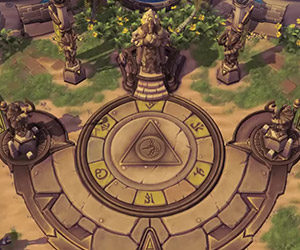 A map dominated by three temples. These occasionally activate. When they active, players may stand below them and face their guardians. These neutral creeps will attack players in the circle, while standing in the circle will cause the temples to shoot lightning at the opposing team’s buildings. Thus, holding the temples requires not only fighting the opposing team but the guardians of the temple. The mercenary camps and the golem in the center of the map add tension and possible side targets, although the power of the temples themselves is undeniable.
A map dominated by three temples. These occasionally activate. When they active, players may stand below them and face their guardians. These neutral creeps will attack players in the circle, while standing in the circle will cause the temples to shoot lightning at the opposing team’s buildings. Thus, holding the temples requires not only fighting the opposing team but the guardians of the temple. The mercenary camps and the golem in the center of the map add tension and possible side targets, although the power of the temples themselves is undeniable.
- You don’t have to kill the guardians, you can kite them and avoid them if you wish. They’re only really dangerous at lower levels.
- When the temples are done shooting, any still living guardians return to dust.
- At 7th and 8th spawn, all the temples will activate, forcing your team to make key decisions. If you are in a strong position, you should get at least two. If you are not, it is important to choose which to surrender and which to contest.
- In general, when two temples activate, it is best to commit to one, rather than risk losing both
- Do not underestimate the power of the temples, it is entirely possible to lose without an enemy hero having laid a finger on your nexus.
- The golem on this map operates slightly different from regular golems. Beware his windstorm.
- The last seconds of the temple are the most important as it fires a concentrated barrage at the enemy buildings. This does not require anyone to be standing in the circle to happen.
- You can contest temples by standing in the circle. It’s usually not worth just contesting unless you can dislodge the enemy.
 Tomb of the Spider Queen
Tomb of the Spider Queen
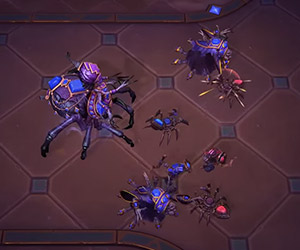 Tomb of the Spider Queen has been described as “a knife fight in a telephone booth”. The description is not entirely inaccurate. This map has many similarities to Blackheart's Bay, but the playstyle is completely different. This map focuses on clearing creep waves to collect gems, which can be turned in at one of two central locations to cause Webweavers to spawn on all lanes. These minions are strong pushers that require the team to back them up to effectively make a dent. The central turn-in points, close lanes, and plenty of smoke mean that caution and aggression are both valid strategies.
Tomb of the Spider Queen has been described as “a knife fight in a telephone booth”. The description is not entirely inaccurate. This map has many similarities to Blackheart's Bay, but the playstyle is completely different. This map focuses on clearing creep waves to collect gems, which can be turned in at one of two central locations to cause Webweavers to spawn on all lanes. These minions are strong pushers that require the team to back them up to effectively make a dent. The central turn-in points, close lanes, and plenty of smoke mean that caution and aggression are both valid strategies.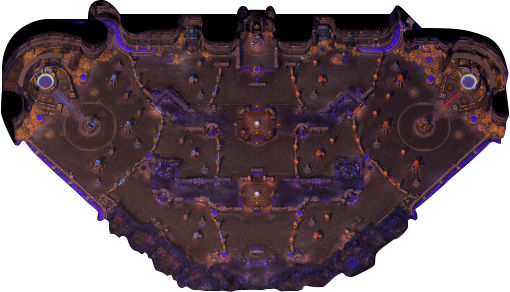
- This map is extremely gank heavy, the lanes are super close together. You are in danger all the time.
- Conversely, the enemy also has to live in constant fear.
- Gems are color coded by team, you cannot collect enemy gems, and the enemy cannot collect your gems,
- There's smoke everywhere, try to be aware of stealthed heroes as best you can.
- Only clear a minion wave if you are reasonably sure that you can gather up all the gems afterwards. Otherwise, wait for the minion wave to push towards your towers and then gather them safely.
- The Webweavers die extremely quickly if they are unprotected. They are not nearly as powerful as the Golem when left alone.
- It’s almost impossible to protect all 3 Webweavers, stick to 1 or 2.
- If an allied hero dies, try to pick up their dropped gems.
- You can, and at times should, contest turn ins, as killing an enemy with 20 gems can allow you swing the game in your favor
- Be aware that gems have a short expiration time. If you can zone enemies you can keep them from getting gems
- There's a backdoor to the main base, be aware of it.
- Gems can be turned in at 2 locations.
Your First Few Games
Sometimes one has an itch to play Heroes, and no one to play with. Those times we’re forced into solo queueing. While not necessarily as fun as playing with friends, its still an enjoyable experience. This means dealing with all different kinds of personalities, from abrasive to friendly. This is simply another skill that all good players must pick up. Heroes is a team game, victory relies on coordination, and you must work to ensure your team cooperates. This is not always easy or possible. It’s frustrating when you are in a game and you get called out for playing badly, but learning to cope with that frustration is part of the game Arguing with your teammates is usually not the way to go, tempting as it may be. Remember, to win a game of Heroes, your team must cooperate. For this reason it pays to be nice.

While this may seem confusing at first, by the time you've played a few games, it will all make sense.
If you are completely new to the game with no moba experience we suggest you play some cooperative games with random people against bots both to get an understanding of the game and of the hero you are playing with. This is the easiest way to make sure you unlock all your talents and the full abilities of your hero before dealing with other people in quick matches.
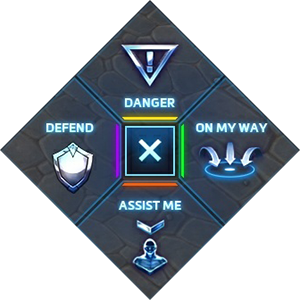
On the map by pinging or by holdingpressing “G” while you ping. this will bring up the option to say: this area is dangerous, help, attack, or that you’re on your way. Now that you’re playing Quick Matches, it's important to remember to communicate. Whether you're in a group with friends or solo queuing it’s always good to tell your team when an opponent leaves the lane. Saying nothing to your team can result in your allies being ganked and your team suffering. You have methods of communicating with your team on the map or on the ground by pinging by holding “G” while you ping. this will bring up the option to say: this area is dangerous, help, attack, or that you’re on your way. These pings can be used both on the map and on your field of vision (like pointing out where an invisible Zeratul or Nova is.)
Sometimes you will meet people who are rude, abrasive and downright mean. They will criticise you for mistakes, real or imagined, and call you names. While sometimes they can be convinced to reason, other times they can’t. If someone is being abusive, and you don’t want to deal with it, just block them
Use this sparingly, Heroes is a game of teamwork, and it's hard to work with a teammate that can’t hear you. Its nice to have the option though.

If you are completely new to the game with no moba experience we suggest you play some cooperative games with random people against bots both to get an understanding of the game and of the hero you are playing with. This is the easiest way to make sure you unlock all your talents and the full abilities of your hero before dealing with other people in quick matches.

Sometimes you will meet people who are rude, abrasive and downright mean. They will criticise you for mistakes, real or imagined, and call you names. While sometimes they can be convinced to reason, other times they can’t. If someone is being abusive, and you don’t want to deal with it, just block them
Use this sparingly, Heroes is a game of teamwork, and it's hard to work with a teammate that can’t hear you. Its nice to have the option though.
Phases of the game
The Laning Phase
During this phase, you have one principal goal. Get as much experience as possible! A level advantage here can easily snowball into a win. In the early game, each wave of minions gives more experience than a hero kill. Its vitally important that every lane be gathering as much experience as possible. Unless your kills manage to deny opponent lane experience, they’re probably not worth it early on. This means that if your team is ignoring a lane, it's your responsibility to go to that lane, so you don’t fall too far behind.
Even in three lane maps there will be two heroes who can roam, or support depending on the circumstances. Some things to keep in mind: if you die in lane, you’re giving up free exp and not getting exp while you’re dead, if you’ve used your moonwell to heal and it’s still on cooldown, it is more worthwhile to hearth out of lane and heal up, than to stick around at low HP and die. Almost always waiting for one of the "roaming heroes" to take over getting lane XP is a good idea. They stay while you port back, then swap again
In this phase, people with previous moba experience might say to “rotate”. A rotation refers to when heroes swap positions on the map. For example if a lane is being pushed hard by Sylvanas and two other heroes, the two ganking heroes might rotate to that lane to help defend, or one of the ganking heroes might take over the middle lane while the middle hero rotates to help defend. Generally speaking these are prime opportunities to try to get kills on the enemy team (when an ally shows up they don’t expect) or push forts.
Remember that bushes in lane are a consideration, they can be used to hide and gain exp in a lane in which opponents would kill you. They can be used to set up clever ambushes by hiding 2 team members and waiting for the enemy to overextend. If you’re afraid of this, actively scout out the bushes with low mana cost abilities, like Malfurion’s Moonfire. Remember Heroes is a game of patience, the more patient team will usually win. No matter how “badly” the lane is going, get as much exp out of it as possible.

Pushing back the lanes early on can help deplete the towers' ammunition.
Try to push the enemy lane back. Forcing towers to run out of ammunition can net some very nice experience when they die, and weakened forts are prime targets during the midgame. Keep in mind that early on towers *hurt*. Getting overaggressive will get you killed. On the converse, hook people into towers, or lure them in tower range, and watch them melt. Avoid getting too frustrated when being forced into being super passive in a lane. Sometimes you’re stuck making bad exchanges, and narrowly avoiding death, it can be tempting to just say "screw it, ill go somewhere else and gank", but staying and just soaking XP is usually preferred.
Even in three lane maps there will be two heroes who can roam, or support depending on the circumstances. Some things to keep in mind: if you die in lane, you’re giving up free exp and not getting exp while you’re dead, if you’ve used your moonwell to heal and it’s still on cooldown, it is more worthwhile to hearth out of lane and heal up, than to stick around at low HP and die. Almost always waiting for one of the "roaming heroes" to take over getting lane XP is a good idea. They stay while you port back, then swap again
In this phase, people with previous moba experience might say to “rotate”. A rotation refers to when heroes swap positions on the map. For example if a lane is being pushed hard by Sylvanas and two other heroes, the two ganking heroes might rotate to that lane to help defend, or one of the ganking heroes might take over the middle lane while the middle hero rotates to help defend. Generally speaking these are prime opportunities to try to get kills on the enemy team (when an ally shows up they don’t expect) or push forts.
Remember that bushes in lane are a consideration, they can be used to hide and gain exp in a lane in which opponents would kill you. They can be used to set up clever ambushes by hiding 2 team members and waiting for the enemy to overextend. If you’re afraid of this, actively scout out the bushes with low mana cost abilities, like Malfurion’s Moonfire. Remember Heroes is a game of patience, the more patient team will usually win. No matter how “badly” the lane is going, get as much exp out of it as possible.

Try to push the enemy lane back. Forcing towers to run out of ammunition can net some very nice experience when they die, and weakened forts are prime targets during the midgame. Keep in mind that early on towers *hurt*. Getting overaggressive will get you killed. On the converse, hook people into towers, or lure them in tower range, and watch them melt. Avoid getting too frustrated when being forced into being super passive in a lane. Sometimes you’re stuck making bad exchanges, and narrowly avoiding death, it can be tempting to just say "screw it, ill go somewhere else and gank", but staying and just soaking XP is usually preferred.
The Midgame
The moment when the midgame starts varies from map to map. The most important thing to remember in the midgame, is that each game is different and your decisions will often be dictated by the map and what your team wants to do. In this section we address some broad concepts, but realistically, not all of them will apply all the time. Having these concepts at your disposal and knowing that they generally apply in the midgame should give you powerful tools.
On some maps the mid game starts around level 8, which is when you’ll start to fight over objectives, however on other maps it can start as early as level 3. Whatever the case, and as a general rule, you will want to prioritize map objectives over laning whenever they appear. But it is important that you remember that laning is still crucial, especially before level 10, and you go back to it when the objectives have passed. There is no clear transition point, but when you start leaving the lane, and fighting over objectives, you can start adapting your gameplay to the midgame.
This is the time where small advantages shine. A one level difference at level 25, is not very significant, however the difference between level 9 and 10 is utterly crucial. If you are level 9 and the opponent is level 10, they *will* obliterate your team in any “fair” teamfight. That type of difference demands a constant avoidance of teamfights, until you at least hit level 10, or for you to take a fight where the enemy is vastly outnumbered (3 to 5) or out of position. To a lesser extent the same holds true for talent gaining levels, 13, 16, 20. If you have them and the opponent doesn’t, push your advantage, force the enemy to lose objectives or commit to a bad fight. On the other hand, if the enemy has this advantage, try to close the gap, or force them to fight in disadvantageous circumstances, like say with their Heroic Abilities on cooldown, or a hero is out of position. The points you should know:
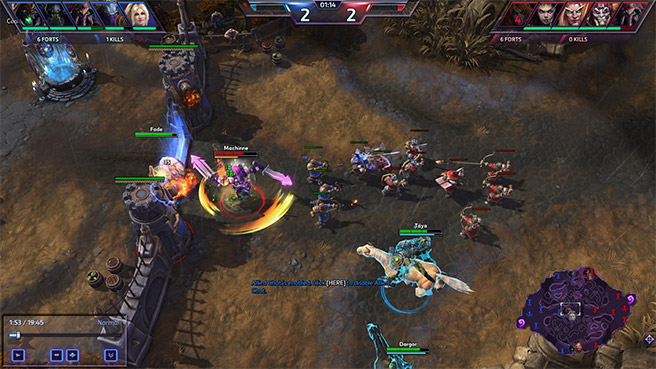
An enemy hero overextends and is punished for their greed
It is perfectly possible to end the game in the midgame. If you get a big enough advantage, you’ll be able to wipe the enemy team and push their core. Beware, no advantage is insurmountable, nothing sucks more than throwing away a 3 level advantage because your team got greedy and tried to take the core, when keeps would be a better choice.
The midgame is a confusing and chaotic time, where your team has to make a lot of important decisions quickly. Read the points here and try to keep them in mind when you have to make a call. Decision making is hard, and experience will hone your instincts.
On some maps the mid game starts around level 8, which is when you’ll start to fight over objectives, however on other maps it can start as early as level 3. Whatever the case, and as a general rule, you will want to prioritize map objectives over laning whenever they appear. But it is important that you remember that laning is still crucial, especially before level 10, and you go back to it when the objectives have passed. There is no clear transition point, but when you start leaving the lane, and fighting over objectives, you can start adapting your gameplay to the midgame.
This is the time where small advantages shine. A one level difference at level 25, is not very significant, however the difference between level 9 and 10 is utterly crucial. If you are level 9 and the opponent is level 10, they *will* obliterate your team in any “fair” teamfight. That type of difference demands a constant avoidance of teamfights, until you at least hit level 10, or for you to take a fight where the enemy is vastly outnumbered (3 to 5) or out of position. To a lesser extent the same holds true for talent gaining levels, 13, 16, 20. If you have them and the opponent doesn’t, push your advantage, force the enemy to lose objectives or commit to a bad fight. On the other hand, if the enemy has this advantage, try to close the gap, or force them to fight in disadvantageous circumstances, like say with their Heroic Abilities on cooldown, or a hero is out of position. The points you should know:
- Know when to secure objectives. If the enemy team is dominating lanes, you either commit to soaking lane exp or try to get mercenaries to get an aggressive push going. If the enemy team isn’t visible in the map, going after map objectives ensures a teamfight, which in some circumstances is what you want.
- In general, if you can pick off a hero, you can force the enemy to retreat, and use the space to secure objectives and at least even the playing field, if not pull ahead. So if you don’t want to set your team behind, avoid being picked off.
- Remember that mercenaries are a form of map objective, while they may not be as flashy as tributes or skulls, a pair of ogres can wreck a fort, push a lane and force the enemy to retreat and defend. Ignoring a golem attacking a fort is a good way to find your core in ruins.
- Try to get a feeling for whether a map objective is worth it as, opposed to a camp of mercenaries.
- Timing is everything you shouldn’t be taking mercenaries just because you can, as they can be easily destroyed if the enemy team is paying attention. As a general rule, capturing them just before an objective spawns is a great idea, because it forces the enemy to either ignore them to capture the objective, and receive a lot of damage from them, or to defend against them, and risk losing the control of the map objective. This is especially true for the Golems.
- Pickoffs are one of the most important things in the game.
- After level 10, if some your team members are dead, the rest of you should stick together, getting a bunch of players picked off consecutively gives the opponent a lot of opportunities to get ahead, and killing a lonely hero is easier than killing a hero when he is close to his teammates.
In general, people being dead gives the opponents opportunities to move around the map as a team, which is something you want to avoid. - If the enemy is gaining or has an experience lead, it is valid to have the team split up and try to gather experience from each lane. Displaying the maximum amount of caution, you cannot afford to lose heroes. If lanes are too pushed out, don’t attempt this. Its okay to, for example, let the enemy capture a tribute in exchange for getting enough lane experience to blunt the level difference.
- You will want to pay attention to the death timers of the enemies, as well as the position and cooldowns of those who are alive. If you are pushing the towers and the gate near one of the keeps, you may decide to attack the keep too or retreat, depending on those factors.If the enemy team is about to spawn for example, you should take into account that they will come back with full health and mana, while your team will surely not be full. This is a good time to retreat and take a mercenary camp for example, this way you keep them pressured, force them to defend, but you don’t risk dying and losing your advantage in the process
- The key is that if the enemy punishes your mistakes, you can easily lose, so avoid making mistakes.

It is perfectly possible to end the game in the midgame. If you get a big enough advantage, you’ll be able to wipe the enemy team and push their core. Beware, no advantage is insurmountable, nothing sucks more than throwing away a 3 level advantage because your team got greedy and tried to take the core, when keeps would be a better choice.
The midgame is a confusing and chaotic time, where your team has to make a lot of important decisions quickly. Read the points here and try to keep them in mind when you have to make a call. Decision making is hard, and experience will hone your instincts.
The Lategame
Eventually, you’ll find yourself at level 20 or so, and discover that even small mistakes can win or lose the game. This is when you know you’ve entered the lategame. This is where all the advantages from earlier start losing their value. This is where every edge you’ve earned needs to be leveraged or lost.
The most important mistake people make in the lategame, is underestimating the enemy team. Losing one teamfight, can easily spiral to losing a defenseless core, or at the very least a few keeps/forts. At this point in the game, each ability matters, cooldowns on Heroic Abilities can swing the game radically, so think before you act.
Single pickoffs are a huge deal. A 4v5 fight is an easy win for the team with five players, each hero matters. So catch enemies out of position, and don’t let your allies wander off. In team fights, figure out who needs to die, and tell your allies. Find the most problematic heroes and make sure they die before they can wreak havoc. A level 24 Valla can wreck your team, but a dead Valla can’t. High level tanks take a ton of damage to kill, generally focus them last.
Defend, defend, defend. If you’re behind, all it takes is the enemy making one big mistake and losing a few key heroes to swing the advantage back in your favor. This is especially true if you aren’t too far behind. The core can do damage, let the enemy come to you. Ambush them when they’re taking objectives. Fight to the last breath, while your core lives, the game isn’t over.
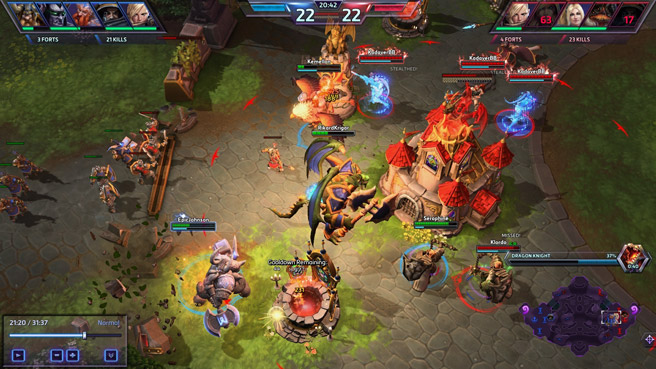
A single mistake snowballs into losing a keep...
Baserace! Desperate measures for desperate times. Sometimes the enemy overcommits to a map objective that could notionally win them the game. If while they’re busy you go after the core, you may find they can’t make it back in time. When going after map objectives, consider this fact. Sometimes running back to base takes too long. In the lategame, a core can go down in 10 seconds. If you’re behind two levels in Haunted Mines and the enemy is busy trying to get a 100 skull golem, you may find you have plenty of time to burn their core to the ground before they can hearth back.
Once you commit, *commit*. Hesitation kills more often than bad calls. If you’re going to baserace, deciding halfway through to retreat will only ensure you lose. If you’re ambushing the enemy at an objective, backing off and letting them take it will only make things worse. This doesn’t mean you need to jump into bad situations, but sometimes there’s a need to see what you can make happen. That said, if a teamfight is going south, it’s better to lose two heroes than five. Part of learning is to see what happens when your level 17 team crashes into the enemy level 22 team, under their core, while all your heroic abilities are on cooldown. (bad things). Losing is a learning experience.
The most important mistake people make in the lategame, is underestimating the enemy team. Losing one teamfight, can easily spiral to losing a defenseless core, or at the very least a few keeps/forts. At this point in the game, each ability matters, cooldowns on Heroic Abilities can swing the game radically, so think before you act.
Single pickoffs are a huge deal. A 4v5 fight is an easy win for the team with five players, each hero matters. So catch enemies out of position, and don’t let your allies wander off. In team fights, figure out who needs to die, and tell your allies. Find the most problematic heroes and make sure they die before they can wreak havoc. A level 24 Valla can wreck your team, but a dead Valla can’t. High level tanks take a ton of damage to kill, generally focus them last.
Defend, defend, defend. If you’re behind, all it takes is the enemy making one big mistake and losing a few key heroes to swing the advantage back in your favor. This is especially true if you aren’t too far behind. The core can do damage, let the enemy come to you. Ambush them when they’re taking objectives. Fight to the last breath, while your core lives, the game isn’t over.

Baserace! Desperate measures for desperate times. Sometimes the enemy overcommits to a map objective that could notionally win them the game. If while they’re busy you go after the core, you may find they can’t make it back in time. When going after map objectives, consider this fact. Sometimes running back to base takes too long. In the lategame, a core can go down in 10 seconds. If you’re behind two levels in Haunted Mines and the enemy is busy trying to get a 100 skull golem, you may find you have plenty of time to burn their core to the ground before they can hearth back.
Once you commit, *commit*. Hesitation kills more often than bad calls. If you’re going to baserace, deciding halfway through to retreat will only ensure you lose. If you’re ambushing the enemy at an objective, backing off and letting them take it will only make things worse. This doesn’t mean you need to jump into bad situations, but sometimes there’s a need to see what you can make happen. That said, if a teamfight is going south, it’s better to lose two heroes than five. Part of learning is to see what happens when your level 17 team crashes into the enemy level 22 team, under their core, while all your heroic abilities are on cooldown. (bad things). Losing is a learning experience.
Teamfighting
Teamfighting is something even pros struggle with. It is also one of the most important facets of the game. There is no way this guide can teach you everything you need to know about teamfighting, as a lot of it comes down to experience and gut calls. That said, here are a few pointers and tips.
Teamfights will often be the deciding factor between defeat and victory. Even an overwhelming advantage can be blunted by a team that executes a teamfight well. The two things to remember are to coordinate and communicate. Let your team know when you’re initiating a teamfight. There are few nastier surprises than jumping in to five enemy heroes and finding that the rest of your team has wandered off to do a golem. Coordinate, if you are disabling an opponent, then he might not be the target you all want to focus fire, if you’re amplifying damage, then that might be the desired target. Focus fire is important. it is often the difference between 3 dead enemies and a won teamfight, and no dead enemies and a lost game. If your team is bad at this, ping out who you want to kill. Every time. They’ll eventually get the idea. The opposite applies to healing, if there are multiple healers on the team, you want to spread the love and keep everyone as high as possible, rather than making sure only one person is at max hp. This advice is of course not iron law, sometimes damage needs to be distributed, and sometimes healing needs to be concentrated.
Positioning. You really, really, really want to avoid being out of position. If you are a lone, low hp hero away from your team, you will likely explode. If you are near your team, you can lure a reckless enemy into the welcoming arms of your team. As the teamfight starts, try to stay near the edges if you’re a ranged hero, it’ll keep you alive and helping. On that note, knowing when to stay in fights at low hp and when to run away is important. If you die, you’re no help to your team. If you run away and your whole team dies, you’re in a difficult situation. In general, if a fight is going south, try to get your team to bail and cut your losses. If you’re winning, don’t get overeager and chase into fortifications. Patience wins more games than haste.

Positioning is everything.
CC, Interrupts and Cleansing. If positioning, communication and coordination are your bread, then these abilities are your butter. Abilities like shrink ray, that reduce the enemies’ ability to flee and damage, are essential. Slowing an enemy hinders their positioning as the fight evolves, and can easily result in their death as they try to flee. This goes double for roots, which keep them from moving at all. Reducing the enemy’s damage is as good as a mass heal, and anything that keeps your teammates alive is a Good Thing. So if you have cleansing abilities available, make sure to dispel these nefarious effects. Knowing when to interrupt enemy channeled abilities is also key. A witch doctor Heroic Ability can ruin your day, but a single stun or knockback can ruin his. Most channeled abilities can be interrupted, and most channeled abilities are really good. If you see someone channeling, hit them with an interrupt.
AoE’s and Heroic Abilities. Area of Effect spells, there’s a reason the strongest AoE effects are relegated to heroic abilities. These dominate teamfights. They force the enemy to consider different positioning, as they cannot cluster without getting multiple people hit by effects, and it makes them more hesitant to engage. Landing an AoE on multiple enemies is fantastic. It turns fights around and is one of the reasons Uther is scary to face.
Teamfights will often be the deciding factor between defeat and victory. Even an overwhelming advantage can be blunted by a team that executes a teamfight well. The two things to remember are to coordinate and communicate. Let your team know when you’re initiating a teamfight. There are few nastier surprises than jumping in to five enemy heroes and finding that the rest of your team has wandered off to do a golem. Coordinate, if you are disabling an opponent, then he might not be the target you all want to focus fire, if you’re amplifying damage, then that might be the desired target. Focus fire is important. it is often the difference between 3 dead enemies and a won teamfight, and no dead enemies and a lost game. If your team is bad at this, ping out who you want to kill. Every time. They’ll eventually get the idea. The opposite applies to healing, if there are multiple healers on the team, you want to spread the love and keep everyone as high as possible, rather than making sure only one person is at max hp. This advice is of course not iron law, sometimes damage needs to be distributed, and sometimes healing needs to be concentrated.
Positioning. You really, really, really want to avoid being out of position. If you are a lone, low hp hero away from your team, you will likely explode. If you are near your team, you can lure a reckless enemy into the welcoming arms of your team. As the teamfight starts, try to stay near the edges if you’re a ranged hero, it’ll keep you alive and helping. On that note, knowing when to stay in fights at low hp and when to run away is important. If you die, you’re no help to your team. If you run away and your whole team dies, you’re in a difficult situation. In general, if a fight is going south, try to get your team to bail and cut your losses. If you’re winning, don’t get overeager and chase into fortifications. Patience wins more games than haste.

CC, Interrupts and Cleansing. If positioning, communication and coordination are your bread, then these abilities are your butter. Abilities like shrink ray, that reduce the enemies’ ability to flee and damage, are essential. Slowing an enemy hinders their positioning as the fight evolves, and can easily result in their death as they try to flee. This goes double for roots, which keep them from moving at all. Reducing the enemy’s damage is as good as a mass heal, and anything that keeps your teammates alive is a Good Thing. So if you have cleansing abilities available, make sure to dispel these nefarious effects. Knowing when to interrupt enemy channeled abilities is also key. A witch doctor Heroic Ability can ruin your day, but a single stun or knockback can ruin his. Most channeled abilities can be interrupted, and most channeled abilities are really good. If you see someone channeling, hit them with an interrupt.
AoE’s and Heroic Abilities. Area of Effect spells, there’s a reason the strongest AoE effects are relegated to heroic abilities. These dominate teamfights. They force the enemy to consider different positioning, as they cannot cluster without getting multiple people hit by effects, and it makes them more hesitant to engage. Landing an AoE on multiple enemies is fantastic. It turns fights around and is one of the reasons Uther is scary to face.
Playing from Behind
It’s going to happen. You’re going to have a game with a team that runs off to all “gank”, dies and allows the enemy to get ahead in experience. Remember, in Heroes experience is shared by your team. This has its advantages and disadvantages. One of its advantages is that it gives you versatility in what you can do. Since only one hero per lane is required to soak all the experience, that leaves 2 heroes on the 3-lane maps free to roam, gank, and help push a particular lane. It also makes heroes like Abathur possible.
However, one of the problems this system faces is that when the enemy gets ahead, the entire team gets ahead. In other mobas, if an enemy hero unlocks their Heroic Ability, they may be the only hero on the enemy team to have done so, thus the difference in power is not that big. In this game however, if the enemy team gets to level 10 first, all the heroes have unlocked their heroic ability, which is a significant difference in power.
To ensure that doesn’t happen, and to help team compositions that have a weak early game but a strong late game, Heroes of the Storm implements an intelligent comeback mechanic: The winning team gains very little experience every time they kill a hero, while the losing team gathers a great amount of experience every team they kill one.
What may seem fairly simple, is in fact an elegant solution. Killing heroes, specially while they are ahead, isn’t easy, and so you’ll need to step up your play. The game won’t gift you anything, you’ll have to earn it by playing better. To defeat the enemy team you’ll need to be very cautious, sticking together and not being picked off alone. You’ll want to avoid fighting when they are a talent tier ahead of you until you catch up, and when you do, try to pick off lonely heroes or force them to fight in an unfavorable position, like a 5 vs 4 or while they are out of position.
In short, to take advantage of this mechanic, you are forced to play better as a team, while at the same time capitalizing on the mistakes of the enemy. However, there is more to it. Let’s say that after a great couple of fights you not only manage to even out the team level, but you also get a little ahead in experience. Still, your forts are gone, so what happens now? The second part of the comeback mechanic kicks in: The death timers.
When you kill an enemy, there is a set amount of time he sits out of the game, until he resurrects at his team’s Hall of Storms. This death timer increases as the game progresses, and is proportional to the hero’s levels.
As we previously mentioned, catching up in experience won’t restore your forts, and although death timers won't restore them either, it will give you enough time to make the enemy forts disappear too. The longer the death timers, the more time you have to destroy structures, secure map objectives, mercenaries, and easily kill even more enemy heroes, which will give you more time. This is what will get you back into the game.
These two mechanics makes comebacks possible on almost every game. Even if you die, since your level is lower, you will respawn faster than the enemy, giving you a chance. But as was stated, the game won’t give you anything for free, you have to earn it.
However, one of the problems this system faces is that when the enemy gets ahead, the entire team gets ahead. In other mobas, if an enemy hero unlocks their Heroic Ability, they may be the only hero on the enemy team to have done so, thus the difference in power is not that big. In this game however, if the enemy team gets to level 10 first, all the heroes have unlocked their heroic ability, which is a significant difference in power.
To ensure that doesn’t happen, and to help team compositions that have a weak early game but a strong late game, Heroes of the Storm implements an intelligent comeback mechanic: The winning team gains very little experience every time they kill a hero, while the losing team gathers a great amount of experience every team they kill one.
What may seem fairly simple, is in fact an elegant solution. Killing heroes, specially while they are ahead, isn’t easy, and so you’ll need to step up your play. The game won’t gift you anything, you’ll have to earn it by playing better. To defeat the enemy team you’ll need to be very cautious, sticking together and not being picked off alone. You’ll want to avoid fighting when they are a talent tier ahead of you until you catch up, and when you do, try to pick off lonely heroes or force them to fight in an unfavorable position, like a 5 vs 4 or while they are out of position.
In short, to take advantage of this mechanic, you are forced to play better as a team, while at the same time capitalizing on the mistakes of the enemy. However, there is more to it. Let’s say that after a great couple of fights you not only manage to even out the team level, but you also get a little ahead in experience. Still, your forts are gone, so what happens now? The second part of the comeback mechanic kicks in: The death timers.
When you kill an enemy, there is a set amount of time he sits out of the game, until he resurrects at his team’s Hall of Storms. This death timer increases as the game progresses, and is proportional to the hero’s levels.
As we previously mentioned, catching up in experience won’t restore your forts, and although death timers won't restore them either, it will give you enough time to make the enemy forts disappear too. The longer the death timers, the more time you have to destroy structures, secure map objectives, mercenaries, and easily kill even more enemy heroes, which will give you more time. This is what will get you back into the game.
These two mechanics makes comebacks possible on almost every game. Even if you die, since your level is lower, you will respawn faster than the enemy, giving you a chance. But as was stated, the game won’t give you anything for free, you have to earn it.
Game Mechanics
This is a general index of game terms and mechanics. If you don’t know what something is/does, you can probably find out about it here.
Vision refers to what you can see on the map, each hero has a line of sight, which is shared by all allied heroes. Map vision also includes what your minions and buildings can see, as well as what watch towers your team controls can see. A little red eye over your head means you’re visible, a blue icon means you’re hiding in the bushes and can’t be seen.
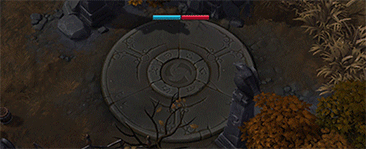
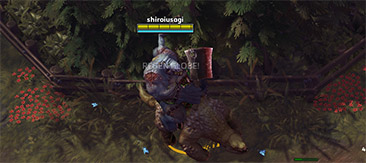
This is the “catch all” term for Cannons, Forts, and Keeps. They only target heroes after all other minions are dead, and rely on ammunition to fire.

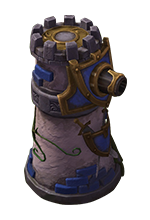
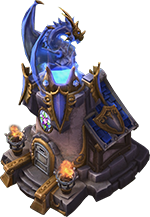
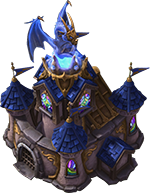

This refers to the units that spawn in each lane, pushing it. Without support, minion waves will clash about evenly. Minions’ starting HP and damage gradually increases as the game goes on, and they are the prime source of exp in the game. There are four types of minions.
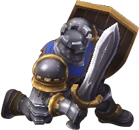



Neutral map objectives common to every map, when neutral mercs are defeated, not only do they grant exp, but they will also join the fight on your team. Mercenaries spawn two minutes after the game begins. Mercenary HP and damage scales as the game goes on. The names included here are the official names, while the parenthetical is what players most often call them. Whenever a merc camp is defeated, you must stand in the golden circle to claim them, which turns the color of your team while you’re standing on it. Enemies can steal these mercs by killing you or pushing you out of the circle, and the mercs won’t be claimed if two people from different teams are standing in the circle. After they are claimed, a Regeneration Globe will spawn, and they’ll take roughly between three and four minutes to respawn, ready to be killed again.

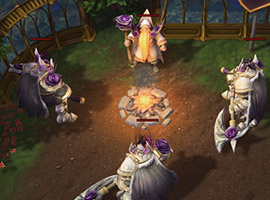
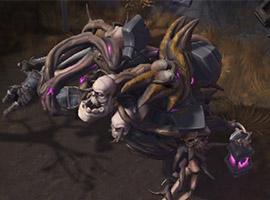
Damage refers to anything that removes HP. Damage can be immediate, or over time, like that inflicted by Envenom. The opposite of damage is healing.



Vision
Vision refers to what you can see on the map, each hero has a line of sight, which is shared by all allied heroes. Map vision also includes what your minions and buildings can see, as well as what watch towers your team controls can see. A little red eye over your head means you’re visible, a blue icon means you’re hiding in the bushes and can’t be seen.

Watch Towers
When captured they grant vision in a given area. If you capture a watch tower in the enemy’s side, can give you an advantage of knowing where you opponents are.
Bushes
Hiding in them puts the hero out of the enemy’s vision unless they have an ability to reveal the area. They can also take the form of smoke from vents like in Blackheart’s Bay.Defensive Structures
This is the “catch all” term for Cannons, Forts, and Keeps. They only target heroes after all other minions are dead, and rely on ammunition to fire.
Gates
A basic defensive structure. These allow the passage of allies, but not enemies. They have no offensive capability and their HP varies the closer they are to the core. Outer gates usually have around 4000 hp, while inner ones have around 6000. These do not give experience.Walls
The lesser sibling of gates, these low HP buildings are stout enough to take a beating, but come in at almost a third of the HP of a gate, again increasing closer to the core. They give no exp and let no-one through.
Ammunition
Ammunition is a resource unique to towers, forts and keeps, as long as they have ammo, they can fire. If they run out of ammo, they will stop firing.
Cannon Tower
The most basic line of defence, the closer to the Core they are, the more HP they have and the more damage they deal. As a rule of thumb, outer towers seem to have in the range of 3000 hp and deal 100 damage per shot, while inside towers have about 4500 hp, and deal 150 damage. They come equipped with 20 rounds of ammunition and recover 1 ammo approximately every 10 seconds.
Forts
Bigger than Towers, smaller than Keeps, their shots inflict a 50% movement and attack speed reduction, and they’re flush with HP, about three times that of a tower, and with 40 rounds of ammunition. They deal 150 damage per shot, but give out a reasonable chunk of experience (800) when killed. Early game advantage can be determined by who has destroyed more forts. Losing forts reduces the zone of safety and makes getting exp more dangerous.
Keeps
These are the bigger, badder forts. They do more damage, pack more hp, but hold the same amount of ammo. The core cannot be brought down unless one or more keeps are dead. Furthermore killing a keep causes catapults to spawn for your team, attacking the now defenseless lane.
Core
The objective the game revolves around, losing your core means losing the game. Fortunately it’s fairly beefy. Its health increases as the game goes on, and it possesses a shield for 50% of its health, and a 220 damage attack that does not require ammo. This does not mean that it will not go down surprisingly quickly to a dedicated assault, or a handful of catapults.Minions
This refers to the units that spawn in each lane, pushing it. Without support, minion waves will clash about evenly. Minions’ starting HP and damage gradually increases as the game goes on, and they are the prime source of exp in the game. There are four types of minions.

Footman

Archer

Wizard

Catapult
The fourth type of minion, these only spawn after the opposing keep in their lane has died. They deal a lot of damage, and can bring down an unattended core fairly fast. They deal about 3% of the core’s health in damage per hit.Mercenaries
Neutral map objectives common to every map, when neutral mercs are defeated, not only do they grant exp, but they will also join the fight on your team. Mercenaries spawn two minutes after the game begins. Mercenary HP and damage scales as the game goes on. The names included here are the official names, while the parenthetical is what players most often call them. Whenever a merc camp is defeated, you must stand in the golden circle to claim them, which turns the color of your team while you’re standing on it. Enemies can steal these mercs by killing you or pushing you out of the circle, and the mercs won’t be claimed if two people from different teams are standing in the circle. After they are claimed, a Regeneration Globe will spawn, and they’ll take roughly between three and four minutes to respawn, ready to be killed again.

Siege Camp
Consisting of two ogres, the siege camp is actually stronger at pushing lanes than the Bruisers are. They also have less hitpoints and are generally easier to capture. They outrange towers and forts, so an unattended group of ogres can bring down a fort unharmed, meaning that they are a threat that must usually be answered as quickly as possible.
Bruisers
The mid tier mercenaries, consisting of 3 knights and a wizard. They’re surprisingly resilient, and while they won’t hit as hard as ogres, they will provide extremely durable chaff, and are worth taking. When capturing them, it is advised to take out the wizard first, as he’s irritating.
Boss
The strongest mercenary camp, consisting of a single massive golem. This monster has the ability to smash the ground, stunning and dealing a fair amount of damage. This is indicated by a green glow surrounding the area to be stomped, so step away from it when it does this. It also roots, as is denoted by a circle targeting the ground where a hero is standing. Avoid being rooted. Finally, its attacks hit like a sack of bricks, so make sure you have enough support to bring him down. On the offensive, the golem will bring down forts if not stopped by heroes, and will often take the investment of the whole team to stop before it deals significant damage.Damage
Damage refers to anything that removes HP. Damage can be immediate, or over time, like that inflicted by Envenom. The opposite of damage is healing.
- Basic Damage - Refers to damage dealt by direct attacks. Things like Valla shooting you directly, a golem punching you to death, tower shots, anything that isn’t based on an ability.
- Skill Damage - Damage dealt by skills, this refers to anything that an enemy hero does to deal damage that requires pushing a button, from Zeratul’s Cleave to Stitches Hooks, damage dealt by these abilities is always considered Skill Damage
Regeneration Globe
Dropped by wizard minions, the Regeneration Globes are a way to get back health and mana in lane. While their bonus is not enormous, it can make the difference between needing to use a moonwell or not. The globe only lasts a handful of seconds, so keeping your enemy away from theirs can effectively deny them the effects of the globe. Also noteworthy is that there are a number of level 1 talents that scale with the number of globes obtained, such as Conjurer’s Pursuit and Regeneration Master. If you’ve picked one of these talents, go after globes aggressively.
Healing Fountain
Found next to the outermost forts, this low HP building is a super effective way to heal and restore mana. When used it heals and restores a large percentage of your health and mana over time. The fountain allows one to leave the lane, get some regeneration, and return to lane. They have a ninety second cooldown, that is tied to your hero. That is, all your allies are free to use it while it may still be on cooldown for you.
Mounting
Most heroes have the ability to “mount”, that is ride a unit across the battlefield, increasing their speed by 40%. Mounting requires a quick channeling time. In chases, it is important to mount up before the enemy does, without giving them a chance to get away or catch up, depending.
Hearthing
A channeled ability that teleports you back to your fountain. The channeling time is about 6 seconds. Hearthing back has the added benefit of a burst of bonus healing. This can mean that even standing in your base, it can be better to hearth back than to walk to the fountain. Because it removes you from the action and has a long channel time, use it with care, as you may not make it back in time for a teamfight.Terminology
AoE - Short for “area of effect,” this refers to a skill that targets a large area. This can be around a hero, or targeted on the ground, and can have a variety of effects including: slow, root, stun, or heal.
Baiting - The action that leads to a player being tricked into thinking they are engaging into a favorable fight, when in reality they are walking into a trap. This is often done by exposing a weak hero and forcing the enemy to chase into your team.
Blink - A skill that allows a hero to jump from one place to another, ignoring terrain. Often used to refer to the level 20 Heroic Talent, Bolt of the Storm
BM - Short for Bad Manner.
Boss - The strongest mercenary that can be captured in game.
Bot - Short for bottom lane.
Buff - A beneficial skill that is a passive or casted onto a hero.
Care - Short for “careful,” meaning there are enemies missing from the map and someone might get jumped on.
CC - Short for “crowd control,” it is when a hero is slowed, rooted, stunned, or polymorphed, keeping them immobilized.
CD - Short for “cool down,” the duration time that it takes a skill to refresh to use again.
Channeling - Is a form of casting that requires the hero to stand still for the duration of the skill, if they move, it will cancel. Some skills let heros move around while channeling, like Sonya’s Whirlwind. Most importantly channeled abilities are interrupted if the caster is stunned, ending them prematurely. .
Cloaked - A hidden hero, can only be detected by a slight ripple on the ground.
Comeback - When the losing team is able to reverse the game into their favor.
Creeps - A term that is sometimes used to refer to minions.
Debuff - Adverse effects that does harm to the hero.
DPS - Means “damage per second”, but it can be used to refer to either high damage heroes (Valla is a good DPS!) or to refer to damage (We need to put the DPS on the Tank)
EXP - Short for experience, all heroes, minions, mercenaries (capture and killing), towers, and forts yield experience. When your team has enough experience, you level up.
Feed/Feeding - When one is constantly dying to the enemy team allowing them to gain a lot of experience giving them the advantage.
Fury - A resource specific to only a few heroes, (in this case Sonya), that is generated both by taking and dealing damage.
Focus Fire - When a team targets one hero to take them down as fast as possible, focusing their damage on a single target.
GG/GGWP - Short for “good game”/ “good game well played”
GLHF - Short for “good luck have fun.”
Gold - A currency that is earned as a result of playing, it can be spent on Heroes, Master Skins and the Piggy Bank mount.
Hearthstone (Hearthing) - A skill every player has that can teleport back the hero to the Nexus. (Also an awesome Blizzard TCG)
Healing Fountain/Moonwell - When clicked it will heal the hero and restore some mana over time. It has a cooldown of 90 seconds.
Heroic Ability - This ability is available at level 10, being the most powerful skill among the basic skills. Usually has long cooldowns.
Heroic Trait - These refer to unique abilities that belong to each hero. Each hero has their own Heroic Trait, like Zeratul's Cloak, or Tassadar’s Oracle
HP - Short for hero’s “health pool.”
Interrupt - Stunning a hero skill with cast time or channeled spell.
Gank - A surprise attack targeting a single hero. Any time a number of heroes converge to bring down one or two enemy heroes, it can be considered a gank.
Ganking - See Gank
Baiting - The action that leads to a player being tricked into thinking they are engaging into a favorable fight, when in reality they are walking into a trap. This is often done by exposing a weak hero and forcing the enemy to chase into your team.
Blink - A skill that allows a hero to jump from one place to another, ignoring terrain. Often used to refer to the level 20 Heroic Talent, Bolt of the Storm
BM - Short for Bad Manner.
Boss - The strongest mercenary that can be captured in game.
Bot - Short for bottom lane.
Buff - A beneficial skill that is a passive or casted onto a hero.
Care - Short for “careful,” meaning there are enemies missing from the map and someone might get jumped on.
CC - Short for “crowd control,” it is when a hero is slowed, rooted, stunned, or polymorphed, keeping them immobilized.
CD - Short for “cool down,” the duration time that it takes a skill to refresh to use again.
Channeling - Is a form of casting that requires the hero to stand still for the duration of the skill, if they move, it will cancel. Some skills let heros move around while channeling, like Sonya’s Whirlwind. Most importantly channeled abilities are interrupted if the caster is stunned, ending them prematurely. .
Cloaked - A hidden hero, can only be detected by a slight ripple on the ground.
Comeback - When the losing team is able to reverse the game into their favor.
Creeps - A term that is sometimes used to refer to minions.
Debuff - Adverse effects that does harm to the hero.
DPS - Means “damage per second”, but it can be used to refer to either high damage heroes (Valla is a good DPS!) or to refer to damage (We need to put the DPS on the Tank)
EXP - Short for experience, all heroes, minions, mercenaries (capture and killing), towers, and forts yield experience. When your team has enough experience, you level up.
Feed/Feeding - When one is constantly dying to the enemy team allowing them to gain a lot of experience giving them the advantage.
Fury - A resource specific to only a few heroes, (in this case Sonya), that is generated both by taking and dealing damage.
Focus Fire - When a team targets one hero to take them down as fast as possible, focusing their damage on a single target.
GG/GGWP - Short for “good game”/ “good game well played”
GLHF - Short for “good luck have fun.”
Gold - A currency that is earned as a result of playing, it can be spent on Heroes, Master Skins and the Piggy Bank mount.
Hearthstone (Hearthing) - A skill every player has that can teleport back the hero to the Nexus. (Also an awesome Blizzard TCG)
Healing Fountain/Moonwell - When clicked it will heal the hero and restore some mana over time. It has a cooldown of 90 seconds.
Heroic Ability - This ability is available at level 10, being the most powerful skill among the basic skills. Usually has long cooldowns.
Heroic Trait - These refer to unique abilities that belong to each hero. Each hero has their own Heroic Trait, like Zeratul's Cloak, or Tassadar’s Oracle
HP - Short for hero’s “health pool.”
Interrupt - Stunning a hero skill with cast time or channeled spell.
Gank - A surprise attack targeting a single hero. Any time a number of heroes converge to bring down one or two enemy heroes, it can be considered a gank.
Ganking - See Gank
Jungling - When a player focuses on capturing mercenaries.
Kiting - Repeated hit and run attacks where the target is kept out of range.
Lane - The path that the minion and mercenaries follow.
Laning - When heroes are occupying the top, middle, or bottom lanes.The focus of laning is either to push or gain exp, or both.
Mana - This is the resource that most of the heroes use to use their skills.It regenerates slowly over time and is replenished by the fountain.
Mercenaries (Mercs) - Neutral map objectives common to every map. When neutral mercs are defeated, not only do they grant exp, but they will also join the fight on your team.
Mid - Short for “middle lane.”
Minions - These are the waves of NPCs that come down the lanes from both sides and meet up in the middle of the map.
MISS/MIA/SS - Meaning the enemy is missing or missing in action from a lane.
Mount - A skill that increases your speed allowing a hero to traverse the map quicker.
Nexus/Fountain - Where heroes spawn at. It also heals and restores mana.
Objectives - These are the mechanical properties that make each map different from each other. For example on Cursed Hollow the team to collect three tributes first curses the enemy team.
OMW - Short for “on my way.”
OOM - Short for “out of mana.”
Pushing - Advancing forward on the lane towards the opponent’s base.
Roaming - When a player moves around instead of staying in lane.
Root - A debuff that holds a hero in place. Rooted heroes can still use attacks and use skills if enemy are in range.
Kiting - Repeated hit and run attacks where the target is kept out of range.
Lane - The path that the minion and mercenaries follow.
Laning - When heroes are occupying the top, middle, or bottom lanes.The focus of laning is either to push or gain exp, or both.
Mana - This is the resource that most of the heroes use to use their skills.It regenerates slowly over time and is replenished by the fountain.
Mercenaries (Mercs) - Neutral map objectives common to every map. When neutral mercs are defeated, not only do they grant exp, but they will also join the fight on your team.
Mid - Short for “middle lane.”
Minions - These are the waves of NPCs that come down the lanes from both sides and meet up in the middle of the map.
MISS/MIA/SS - Meaning the enemy is missing or missing in action from a lane.
Mount - A skill that increases your speed allowing a hero to traverse the map quicker.
Nexus/Fountain - Where heroes spawn at. It also heals and restores mana.
Objectives - These are the mechanical properties that make each map different from each other. For example on Cursed Hollow the team to collect three tributes first curses the enemy team.
OMW - Short for “on my way.”
OOM - Short for “out of mana.”
Pushing - Advancing forward on the lane towards the opponent’s base.
Roaming - When a player moves around instead of staying in lane.
Root - A debuff that holds a hero in place. Rooted heroes can still use attacks and use skills if enemy are in range.
Silence - A debuff that restricts the hero from using any ability.
Shielding - A buff that absorbs damage on a hero.
Sheep - Just another way of saying polymorph.
Primary Skill - Default ability the hero starts with.
Skillshot - Abilities that do not automatically hone in on the target and requires prediction and accuracy of one’s clicks to land.
Skin - A cosmetic-only change that is used on a hero/mount to change their looks/color. There are skins that are bought from the store and master skins that are acquired with gold.
Slow - A debuff that reduces a hero’s movement speed.
Stun - A debuff that immobilizes the hero. A stunned hero cannot move or use skills.
Teamfight - Usually used to refer to an engagement which involves a large number of members from both teams, or both teams in their entirety.
Top - Means top lane.
Ultimate - A term used to refer to Heroic Abilities.
Watch Tower - A capture point that grants you vision around the specific area.
Shielding - A buff that absorbs damage on a hero.
Sheep - Just another way of saying polymorph.
Primary Skill - Default ability the hero starts with.
Skillshot - Abilities that do not automatically hone in on the target and requires prediction and accuracy of one’s clicks to land.
Skin - A cosmetic-only change that is used on a hero/mount to change their looks/color. There are skins that are bought from the store and master skins that are acquired with gold.
Slow - A debuff that reduces a hero’s movement speed.
Stun - A debuff that immobilizes the hero. A stunned hero cannot move or use skills.
Teamfight - Usually used to refer to an engagement which involves a large number of members from both teams, or both teams in their entirety.
Top - Means top lane.
Ultimate - A term used to refer to Heroic Abilities.
Watch Tower - A capture point that grants you vision around the specific area.
Things to remember
While in public games keep these tips in mind.
- Don’t fight when you’re outnumbered.
- Pay attention to map objectives.
- Listen to your team.
- Talk to your team. Unless you need to, don’t mute your team.
- Use your cooldowns responsibly. Nothing sucks as much as not having your Heroic Ability when you need it.
- Don’t run away from a healer trying to heal you. If there’s a healer running after you, there’s a real chance they’re trying to heal you.
- A lesson many WoW players will remember: don’t stand in the fire. If it is an enemy AOE, get out of it as fast as possible.
- Another concept familiar to WoW players, don’t leeroy jenkins. Charging at the enemy team alone will result in bad times.
- A little red eye over your head means you’re visible, a blue icon means you’re hiding in the bushes and can’t be seen.
- Obviously this isn’t as effective if you’ve been spotted walking into the bush.
- Remember to mount up.
- If you’re low on HP, either hearthstone back to base or use a moonwell.
- Keep map awareness. The minimap is a powerful tool to know where the enemy is and is not. If no one is in lane, they’re probably going after objectives. Or trying to gank you.
- Stealthed heroes shimmer on the map. If you’re paying attention, you can see them near you.
- Nova and Zeratul are stealthed heroes, if they’re on the enemy team, take care.
- Don’t be a poor sport and give up early. Killing heroes isn’t everything. Heroes is a game of comebacks. A little coordination can turn defeat into victory.
- When you’re new, it's more important to play defensively than ever. You don’t know how to estimate the relative strength of enemies, you’re not sure of how much impact map objectives have, so its better to contest than to try to trade.
- Chasing after a low HP enemy hero is often a recipe for disaster. If you don’t know where their team is, or have a quick way to catch up, you’ll either walk into an ambush or just let them get away. Better to let them live and avoid being lured out of position.
- In general, if the enemy starts capturing mercenary camps, you can counter by capturing the ones on your side of the map.
- Ranged heroes can, and should, kite enemy melee Heroes.
- You can tab to see what heroes are on the enemy team, and click “show talents” to see what talents they’ve picked. This can be really useful.
- Any and all of these tips can be situationally disregarded. Sometimes you do have to charge into a group of five enemies while your team is halfway across the map and you’re at 10% hp, in order to keep them from getting a key objective or to buy time. This will not usually be the case.
Keep Trying.
Yes, you suck and are going to lose a lot. People will call you a noob. You will throw won games, and feel bad about it. You will find that you picked all the wrong talents and are about as effective as a wet sponge. You’ll forget to stand in a circle to claim mercenaries. These are all normal mistakes to make. We’ve all made them at one point or another. You will get better. In time, you will be tempted to rage. Remember the other people playing are also people. You were once like them, before you became good at heroes. Keep in mind the most important thing to do is to try to improve, and have fun. That is why we play games after all, to have fun, and this is at its core, a supremely fun game. Be nice, and have fun.
See you in the Nexus.

